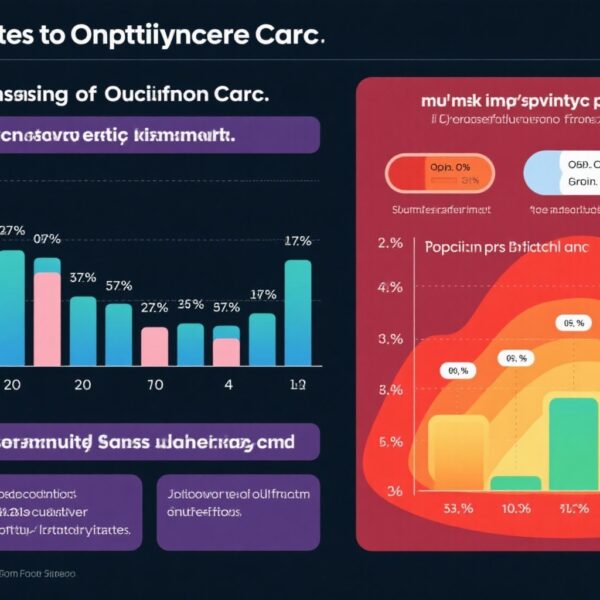Highlights
– In a post‑hoc analysis of the randomized RINO oxygenation trial, 147/494 extubated patients developed post‑extubation respiratory failure; 83 received rescue NIV and 64 were re‑intubated immediately.
– Overall NIV failure (need for intubation despite NIV) was 58%; failure rates were similar in hypoxemic and hypercapnic/respiratory-distress phenotypes.
– After inverse probability weighting, rescue NIV was associated with lower ICU mortality (adjusted OR 0.31; 95% CI 0.12–0.82; p = 0.019) and no clear difference in hospital mortality (adjusted OR 1.01; 95% CI 0.43–2.33; p = 0.99). Bayesian analyses showed high posterior probability that NIV reduced ICU mortality but uncertain effects on hospital mortality.
Background
Extubation is a critical transition point in the care of mechanically ventilated patients. Although many patients are successfully liberated from invasive mechanical ventilation, a clinically important minority develop post‑extubation respiratory failure and require rescue therapy. Management options include immediate re‑intubation or a trial of noninvasive ventilation (NIV).
Preemptive NIV applied immediately after extubation in selected high‑risk patients (for example, those with chronic obstructive pulmonary disease [COPD] or hypercapnia) is supported by randomized data demonstrating reduced re‑intubation and improved outcomes in some populations. By contrast, rescue NIV — applied after respiratory failure has developed post‑extubation — has been discouraged in guideline statements historically because observational studies suggested that NIV could delay necessary re‑intubation and thereby increase mortality. Despite this, rescue NIV remains used in many ICUs, particularly when clinicians aim to avoid the complications of re‑intubation. The RINO trial post‑hoc analysis reported here provides contemporary, protocolized information on outcomes associated with rescue NIV in patients who develop respiratory failure after extubation.
Study design
This report is a post‑hoc analysis of the randomized RINO trial (registered NCT02107183), which originally compared high‑flow nasal oxygen to Venturi mask oxygen in hypoxemic patients after extubation. From the trial cohort of 494 extubated patients, investigators identified those who developed post‑extubation respiratory failure during oxygen therapy using prespecified clinical criteria. Management of respiratory failure — whether rescue NIV or immediate re‑intubation — was left to physician discretion, but criteria for re‑intubation during NIV were prespecified in the protocol.
Patients who received rescue NIV were compared to those who underwent immediate re‑intubation. The primary analyses used inverse probability of treatment weighting (IPTW) to adjust for measured confounders and logistic regression to estimate adjusted odds ratios (aORs) for outcomes. Additionally, Bayesian regression was used to generate posterior probabilities for clinically relevant outcome differences under a range of priors.
Key findings
Population and timing: Among 494 extubated participants, 147 (30%) developed post‑extubation respiratory failure while receiving oxygen therapy. Respiratory failure presented a median 37 hours after extubation (IQR 13–85). Of these, 83 patients (57%) were managed initially with rescue NIV, while 64 (43%) underwent immediate re‑intubation.
NIV performance: The overall NIV failure rate — defined as need for intubation while receiving NIV — was 58%. Failure rates were similar across physiologic subgroups: 60% in patients with predominantly hypoxemic respiratory failure versus 56% in those with hypercapnia and/or overt respiratory distress (p = 0.82). Thus, more than half of patients treated with rescue NIV ultimately required re‑intubation.
Adjusted outcomes: After IPTW to account for baseline differences between groups, rescue NIV (versus immediate re‑intubation) was associated with a significantly lower ICU mortality (adjusted odds ratio 0.31, 95% CI 0.12–0.82; p = 0.019). Hospital mortality did not differ between groups (adjusted odds ratio 1.01, 95% CI 0.43–2.33; p = 0.99).
Bayesian analyses: The posterior probability that rescue NIV reduced ICU mortality exceeded 90% across priors tested, supporting a likely ICU benefit. However, the posterior probability that NIV did not increase hospital mortality was modest and sensitive to the prior: 44% under a noninformative prior, 47% under a skeptical prior, and 39% under a pessimistic prior. In other words, the analysis could not exclude a neutral or harmful effect on hospital survival with acceptable certainty.
Secondary and contextual outcomes: The published report did not demonstrate subgroup differences in NIV success by respiratory phenotype, and the high failure rate emphasizes that NIV is frequently temporizing rather than definitive in this setting. Details on ICU or hospital length of stay, ventilator‑free days, and complication rates were not emphasized in the summary but are relevant to clinical interpretation.
Interpretation and clinical implications
The analysis provides several important, pragmatic insights for ICU clinicians:
- High NIV failure rate: More than half of patients who received rescue NIV required subsequent intubation. Clinicians should therefore expect frequent NIV failure and closely monitor patients treated with rescue NIV.
- Possible ICU mortality benefit: After statistical adjustment, rescue NIV was associated with a substantially lower ICU mortality. Several mechanisms could explain this: avoiding re‑intubation and its immediate complications in patients who respond to NIV, shorter invasive ventilation exposure in those who eventually require re‑intubation, or residual confounding despite adjustment (for example, selection of lower‑risk patients for NIV).
- Uncertain effect on hospital mortality: The lack of difference in hospital mortality — and the Bayesian uncertainty around this outcome — mean that rescue NIV cannot be said definitively to be safe or harmful with respect to final hospital survival. ICU survival improvements may not translate into a hospital survival benefit if subsequent events offset early gains.
- Importance of protocolized care: The trial used prespecified criteria for re‑intubation during NIV. Clear, pre‑defined thresholds for escalation likely reduce the risk of prolonged, harmful delays to intubation and may account for the absence of a signal for increased hospital mortality. This suggests that protocolized use of rescue NIV, with low thresholds for re‑intubation, might mitigate previously observed harms.
- Patient selection matters: The similar NIV failure rates in hypoxemic and hypercapnic presentations indicate that phenotype alone is not an infallible predictor of NIV success. Historical data suggest hypercapnic COPD exacerbations are more NIV‑responsive, but real‑world complexity and timing after extubation modulate response.
Expert commentary and limitations
This post‑hoc study offers useful, contemporary data, but clinicians and guideline committees should weigh several limitations before changing practice:
- Nonrandomized comparison within a randomized trial: Treatment assignment to rescue NIV versus immediate re‑intubation was not randomized. Although IPTW can adjust for measured confounders, residual confounding from unmeasured factors (e.g., clinicians’ gestalt, frailty, do‑not‑intubate status) may bias results.
- Selection bias: Patients chosen for NIV may have been perceived as more salvageable or less severely ill, which could account for lower ICU mortality.
- Post‑hoc nature: The analysis was not a prespecified randomized comparison of rescue NIV versus immediate re‑intubation and should be considered hypothesis‑generating.
- Outcome granularity: The summary focused on mortality outcomes; data on ventilator‑free days, ICU/hospital length of stay, complications related to NIV (aspiration, mask intolerance), and patient‑centered outcomes would aid decision‑making.
- Generalizability: The RINO trial context, ICU staffing, experience with NIV, and adherence to prespecified re‑intubation criteria may not be reproducible in all centers. Centers with variable monitoring or delayed escalation thresholds may not replicate these findings and could suffer harm from delayed intubation.
Current guideline statements caution against rescue NIV for post‑extubation respiratory failure primarily because delayed re‑intubation has previously been associated with worse outcomes. The RINO post‑hoc analysis suggests that, in experienced centers using predefined re‑intubation criteria, rescue NIV does not clearly increase hospital mortality and may reduce ICU mortality. However, definitive practice change requires randomized evidence.
Practical recommendations for clinicians
Until randomized data are available, clinicians considering rescue NIV for post‑extubation respiratory failure should:
- Use explicit, predefined criteria for initiation of NIV and, crucially, for timely re‑intubation if NIV fails.
- Apply NIV preferentially in settings with experienced staff, continuous monitoring, and the ability to re‑intubate rapidly if needed.
- Recognize that NIV will fail in a substantial proportion of patients (≈60%) and maintain a low threshold to secure the airway when objective deterioration occurs.
- Individualize decisions based on patient factors (baseline disease such as COPD, neurological status, cough strength), goals of care, and the risk–benefit balance of re‑intubation for that patient.
Research implications and future trial design
The authors appropriately call for a randomized controlled trial to re‑evaluate rescue NIV efficacy. Key design considerations include:
- Eligibility: Clear definitions of post‑extubation respiratory failure, exclusion of patients with immediate life‑threatening failure requiring emergent intubation, and stratification by phenotype (hypoxemic vs hypercapnic) and underlying disease (COPD, heart failure, neuromuscular disease).
- Interventions: Protocolized NIV versus immediate re‑intubation with standardized re‑intubation thresholds, precise settings and adjuncts, and mandatory monitoring protocols to minimize delayed intubation risk.
- Outcomes: Primary outcome should be clinically meaningful (e.g., 28‑day or hospital mortality). Secondary outcomes should include ICU mortality, ventilator‑free days, ICU and hospital length of stay, NIV‑related complications, functional outcomes, and patient‑centered measures.
- Sample size and powering: Estimates should reflect expected high NIV failure rates and plausible effect sizes on mortality; interim safety monitoring for excess mortality in either arm is essential.
- Implementation: Multicenter design with centers of varying NIV experience would enhance generalizability; process measures (adherence to re‑intubation criteria) must be tracked.
Conclusion
In this post‑hoc analysis of the RINO trial, rescue NIV for post‑extubation respiratory failure was commonly used but unsuccessful in over half of treated patients. When used within a protocolized framework with prespecified criteria for re‑intubation, rescue NIV was associated with lower ICU mortality but did not change hospital mortality. The findings are hypothesis‑generating and support conducting a randomized controlled trial to determine whether rescue NIV can safely reduce morbidity and mortality after extubation. In the meantime, rescue NIV should be applied cautiously, with strict monitoring and predefined thresholds for escalation to invasive ventilation.
Funding and trial registration
The analysis derives from the RINO trial cohort. The clinical trial was registered at clinicaltrials.gov (NCT02107183) on April 8th, 2014. Funding sources and detailed trial funding statements appear in the primary RINO publication.
References
Grieco DL, Jaber S, Zakynthinos S, Demoule A, Ricard JD, Navalesi P, Vaschetto R, Hraiech S, Klouche K, Frat JP, Lemiale V, Fanelli V, Chanques G, Longhini F, Mancebo J, Gualano MR, Ferreyro BL, Brochard LJ, Antonelli M, Maggiore SM; RINO trial study group. Use of rescue noninvasive ventilation for post‑extubation respiratory failure. Crit Care. 2025 Nov 4;29(1):470. doi: 10.1186/s13054-025-05689-w. PMID: 41188988; PMCID: PMC12584535.



